HERE’S LOOKING AT YOU, KID
After setting up several feeders to attract more birds to his yard, Kyle Barr of Rocky Point was rewarded with a visit from a stunning female cardinal on May 21.
Send your Photo of the Week to [email protected]
HERE’S LOOKING AT YOU, KID
After setting up several feeders to attract more birds to his yard, Kyle Barr of Rocky Point was rewarded with a visit from a stunning female cardinal on May 21.
Send your Photo of the Week to [email protected]
Amidst the COVID-19 Pandemic, local pizzerias have teamed up with the Town of Smithtown in a collaborative effort to help find loving homes for rescue dogs and cats at the Smithtown Animal Shelter. Each pizzeria has taped adoption flyers to pizza boxes which are distributed to customers throughout the Township. Each flyer includes important information about the animal seeking a loving home, including age, gender and the needs of each adoptee.

“The truth is that it’s an ideal time to consider adopting a loving animal in need of a second chance. So we started making calls to local establishments currently operating as essential businesses. The response was overwhelmingly positive, as many of these establishments have stepped up to help the community from the beginning of the COVID-19 pandemic,” said Councilwoman Lisa Inzerillo.
The main objective of the Pizza Box Adoption campaign is to attract new eyes to the longest shelter residents, often passed up because of age, size or breed misconception. Every adoptee featured on these flyers is truly deserving of a second chance.
Participating businesses in the adoption campaign include Buona Sera in Smithtown, Monte’s in Smithtown, Three Bambino’s in Smithtown, Mannino’s in Smithtown, Ciro’s Pizza in Smithtown, Alpine Bakery in Smithtown, Branchinelli’s in Hauppauge, Mama Sbarro’s in Hauppauge, Gino’s in Kings Park, Legend’s in Kings Park, Ciro’s in Kings Park and Pizzaiola in Commack.
Photos courtesy of Town of Smithtown
MEET CIRA AND SAMPSON!
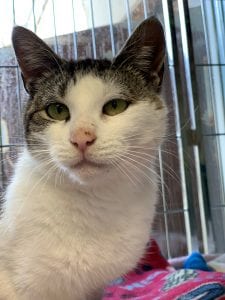
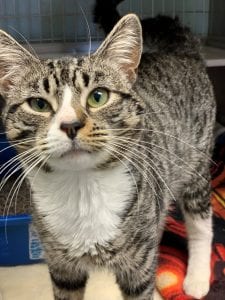
This week’s shelter pets are Cira, left, and Sampson, right, from the Smithtown Animal Shelter.
Cira is a one-year-old female domestic shorthair mix who was brought in to the shelter as a stray. An injury from her life as a stray caused her to lose some of her tail, but this only adds to her charm. This love bug has a very gentle and loving demeanor, with an unlimited supply of cuddles and affection. Her perfect home would be with children where she can get (and give!) all kinds of love and friendship.
Sampson is a 2-year-old male domestic shorthair who was found living as a stray and was brought into the shelter by a good samaritan. He was underweight at first, but the team at the shelter have helped him to add a few pounds and get him healthy again Sampson not only has a huge appetite for food, but he also craves love! He is a very outgoing and sweet little guy who just wants to give and get love anywhere he can find it. He may be small in stature, but he has a big heart and an even mightier spirit inside. Sampson gets along well with other cats and is good for a family with children.
If you are interested in meeting either Cira or Sampson please fill out an adoption application online at www.townofsmithtownanimalshelter.com.
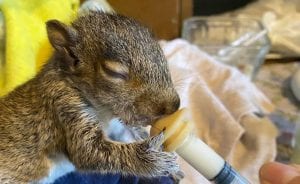
Learn about wildlife and interact live with an educator each week on the Sweetbriar Nature Center Facebook page every Thursday at 2:30 p.m. The staff will share a different animal with you along – a baby bird, rabbit, opossum – with a story or a talk.
Donations are greatly appreciated for the over 100 resident animals that are currently being cared for at the center. Items from Sweetbriar’s wish list (www.sweetbriarnc.org) may be dropped off a the center’s front door and monetary donations may be made directly during the Facebook live program. Sweetbriar Nature Center is located at 62 Eckernkamp Drive in Smithtown. For more information, call 631-979-6344.
Senior scientist at the National Audubon Society, Dr. Brooke Bateman, will offer “Virtual Birding” on Wednesday, May 27 from 1:30 to 2:30 p.m. via Zoom as part of Ward Melville Heritage Organization’s (WMHO) Master Class Series.
Dr. Bateman’s first summer job as a teenager was aboard WMHO’s “Discovery” pontoon boat cruises where she would see snowy egrets, night herons and osprey along Stony Brook Harbor into West Meadow Creek. During this session she will explore spring migration of birds from the Arctic to Long Island, the beauty and science of many species of birds across the world, as well as her invention, “Climate Watch,” a tool to monitor and combat the effects of climate change on birds.
In her role at the Audubon Society she has led a team of scientists in developing the 2019 Birds and Climate Change Report. She is also the Director of Climate Watch, where she works with community volunteers to understand how climate change currently affects birds in North America. Her research focus is on spatial ecology and conservation, emphasizing the effect that extreme weather events and climate change have on biodiversity.
To register for this free event please email [email protected] or call 631-751-2244.
Two friends on the staff of the Suffolk County Vanderbilt Museum in Centerport are engaged in a poetry-photo challenge. Their goal is to lift the spirits of their quarantined colleagues.
Ed Clampitt has been a member of the Museum’s security staff for four years. He challenged Ellen Mason, a volunteer tour guide for 14 years, to write poems inspired by his photos. Clampitt, who also has written some of the poems, likes to record seasonal beauty at Eagle’s Nest, the spectacular 43-acre Vanderbilt Estate that is also home to the Vanderbilt Museum and Reichert Planetarium.

“During discussions about our upcoming children’s book, Ellen discovered her previously untapped talent for writing poetry,” Clampitt said. “I enjoy being her muse and inspiring that wonderful talent to blossom!”
Mason said, “Ed suggested that he take photographs at the Vanderbilt and challenged me to write poems to correspond to them. He surprises me with the photos and gives me no prior information. And I surprise him with the poems.”
Then the creative partners email the results to the Vanderbilt staff and members of the Board of Trustees. Their responses: delight and gratitude.
“It’s such a pleasure to receive their poems and photos,” said Elizabeth Wayland-Morgan, the Vanderbilt Museum’s interim executive director. “Ed and Ellen’s creations remind us of how lucky we are to work in such beautiful surroundings, especially now when we cannot physically be at Eagle’s Nest. Their pictures and words are inspiring.”

Clampitt, a Huntington resident who also has worked for Stop & Shop supermarkets for 40 years, is a front-line worker during the COVID-19 pandemic. He is also co-creator and author of Team Dawg, a character-education program and children’s book series that has been widely used in elementary schools throughout Long Island.
Mason, a Stony Brook resident and retired Centereach High School English teacher, leads tours of the Vanderbilt Mansion. She tells visitors stories about the Vanderbilt family and provides details on the Mansion’s architecture and centuries-old art and furnishings. During summer Living History tours, she and the guides dress in 1930s costumes to portray famous summer guests of Rosamond and William K. Vanderbilt II.
Here are two of Mason’s poems and one by Clampitt, with four of Clampitt’s photos taken on the Vanderbilt Estate:
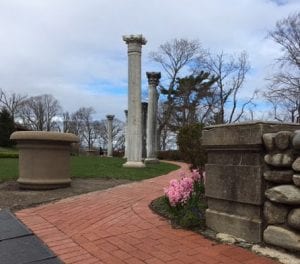
By Ellen Mason
Wrought iron gates / Now closed to us;
No sound of car / Or van or bus.
No children shout /Or laughter rings
Amid the trees /Where birds still sing.
The empty paths / And courtyard bare
Of visitors /A sight so rare.
A vista /Just around the bend,
Might give us hope / And chance to mend.
To breathe the air / At Eagle’s Nest,
Would lend our hearts / And souls some rest.
The day will come / When we’ll return,
To hug and share / Our lessons learned.
We’ll walk the paths / Blue sky above,
And celebrate / This place we love.
 Night in the Museum
Night in the MuseumBy Ellen Mason
The grounds are dark, /And silence reigns;
No traffic noise / On roads or lanes.
No human sounds /Disturb the night,
As paths are bathed /In pale starlight.
Within the hushed /Exhibit halls,
Some species stir /On floors and walls.
With restlessness, /They shift and shake,
And move their eyes, /And try to make
Some sense of what / Has come to pass:
No students here / With friends and class,
In lines of two, / With cell phones poised,
They used to laugh /And make loud noise
Where are the folks, / The steady band,
Who climb the stairs / With map in hand?
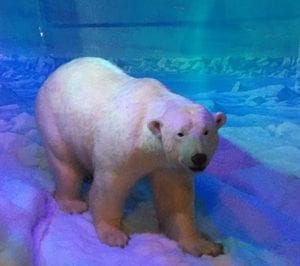 The whale shark swings / Both to and fro,
The whale shark swings / Both to and fro,
To catch the sight: / No one below.
The polar bear, / Now wide awake,
Believes there must be / Some mistake.
In the museum, / High on the hill,
In quiet rooms, / Alone and still,
The sharks, the eels, / The manatee,
Hang, waiting for /Humanity
Their vigil here, /Throughout the night,
Continues on / In morning light.
And so they wait, / And hope to learn,
Why we were gone, / When we return.
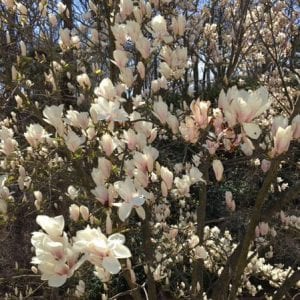 The Plan
The PlanBy Ed Clampitt
She’s still hard at work, / Preparing this place,
For the day coming soon, / When we meet face to face.
Each day brings new changes, /Some larger, some small,
She knows in her heart, /We feel blessed by them all.
Mother Nature the Wonder /Signs of hope that abound,
Just trust in her plan / What’s been lost will be found.
MEET PEGGY!
This week’s shelter pet is Peggy, an adorable seven-month-old female domestic shorthair who is patiently waiting at the Smithtown Animal Shelter for her furever home. Here’s her story:
Peggy came to the shelter as part of the Trap-Neuter-Release program, and she instantly started looking for affection. Peggy is gentle, and sometimes can be a little shy, but she loves to be loved by people! She’s great with children, and would do well in a home with other feline friends. In the past, Peggy had to deal with a ruptured ear drum, but she has since improved her condition and is now feeling much better and happier. She has learned to come out of her shell recently, and she would love the opportunity to socialize and make new friends! Her perfect home would be a quiet place where she can cuddle, lounge around, and play all day.
*Due to the health risk presented by the COVID-19 pandemic, there will be limited public access to the shelter. If you are interested in meeting Peggy please fill out an adoption application online at www.townofsmithtownanimalshelter.com.
The Smithtown Animal & Adoption Shelter is located at 410 Middle Country Road, Smithtown. For more information, call 631-360-7575.
Reviewed by Jeffrey Sanzel
“A sperm whale learns who she will be journeying with, a macaw casts a covetous eye on a beautiful neighbor, a chimpanzee learns to pay to play. Culture creates vast stores of unprogrammed, unplanned knowledge. The whole world speaks, sings, and shares the codes.”
Carl Safina’s latest book, Becoming Wild: How Animal Cultures Raise Families, Create Beauty and Achieve Peace (Henry Holt and Co.), is a fascinating look at the world of animal culture. It is an analysis of what is passed down (inherited) and what is learned (culture).
Much of the study focuses on communication within the species and how animals form their own societies. “A lot of learning travels socially from parents to offspring or from a group’s elders.” the author doesn’t so much redefine the term culture but, instead, encourages us not to be quite so human-centric in our perceptions.
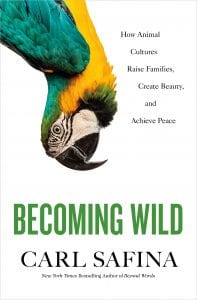 Safina divides the book into the study of sperm whales (families); scarlet macaws (beauty); and chimpanzees (peace). Each of the three sections is rich, detailed and engaging enough to be a book onto itself. He has brought them together under the umbrella of his exploration of culture.
Safina divides the book into the study of sperm whales (families); scarlet macaws (beauty); and chimpanzees (peace). Each of the three sections is rich, detailed and engaging enough to be a book onto itself. He has brought them together under the umbrella of his exploration of culture.
Each is given a detailed history of the species; description of their habitats; personal characteristics; intersection with the human world; and many fascinating details in both macro and microcosm. This is expertly mixed with his first-hand accounts of his experiences among them as well as the people with whom he takes the journey. It is both objective and wholly personal.
His observations are enlightening: “Chimps horrify and delight us because we recognize in them parts of ourselves. We see in them aspects of our own passions, and so they hold us in fascination. We cannot look away. So much of what is uncomfortable for us in watching chimps is their excruciating similarity to us.” The book is rife with these epiphanies that are presented so simply and yet with such acumen.
One point that Safina makes is the debate over nature vs. nurture. His belief is that it is impossible to separate them as they interact. “Humans,” he writes, “are genetically enabled to acquire any human language. But we must still learn a language. Genes facilitate the learning, but they do not determine whether we will speak Russian.” Applying this to the terms of his overall thesis: “Genes determine what can be learned, what we might do. Culture determines what is learned, how we do things.”
Safina has exceptional clarity and explains his ideas with focus and an underlying hint of humor that bring the reader further into his universe. There are a handful of black-and-white sketches but there are eight pages of glorious color plates. These should be studied prior to reading each section as they will give the ideal visual compliment to the descriptions.
Safina writes in engaging prose, rich in detail, vivid in his descriptions. The depictions of these beings in their habitats truly give a sense of place in a thrilling and absorbing way.
The fact that he is out there, in the midst of it, gives a sense of his joy and wonderment and his unceasing desire to understand. He never loses his awe of the depth and breadth of the natural world.
He is a teacher, a student, and a tour guide. “I seek encounters that will enable me not just to see … not just to observe … but to penetrate past the labels and feel the beings as selves, living with their families, sharing the air where our two worlds meet.” Safina succeeds in his goal —and shares with grace, passion, and honesty.
An ecologist and a MacArthur Fellow, Carl Safina is the author of numerous books on the human relationship with the rest of the living world. He holds the Endowed Chair for Nature and Humanity at Stony Brook University and is founder of the not-for-profit Safina Center.
“Becoming Wild” is available online at bookrevue.com, barnesandnoble.com and Amazon.com. Learn more at CarlSafina.org.
MEET BETTY BOOP!
This week’s shelter pet is an eight-year-old female pit bull terrier mix named Betty Boop, currently waiting at the Smithtown Animal Shelter for a family to adopt her. Named after the iconic cartoon diva (who was originally designed as a dog), Miss Boop can’t get enough of people, and volunteers at the shelter can’t get enough of her!
This ball of love was brought in to the shelter by a good samaritan who found her looking lost at a nearby train station. It was quickly discovered how attached she gets to everyone when she cried watching the good samaritan leave. She doesn’t like to see any of her new friends go!
Betty Boop is the perfect combination of calm, affectionate, and sweet all rolled into a 70 pound ball of love. Her eyes say it all; she oozes love and adoration for every new person she meets. While she’s great with children, she would prefer to be the only pet in her home.
*Due to the health risk presented by the COVID-19 pandemic, there will be limited public access to the shelter. If you are interested in meeting Betty Boop please fill out an adoption application online at www.townofsmithtownanimalshelter.com.
The Smithtown Animal & Adoption Shelter is located at 410 Middle Country Road, Smithtown. For more information, call 631-360-7575.
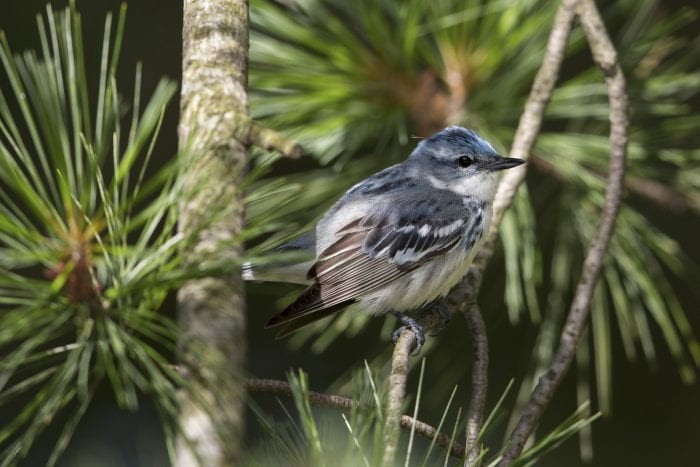
By John L. Turner
For many years there has been a broad public perception that the primary effect of dumping excessive amounts of carbon dioxide (CO2) into the atmosphere, from the burning of fossil fuels (and the release of other gases such as methane from landfills, gas and oil wells, and other sources), was the warming of the atmosphere — a phenomenon that was first called “global warming” or the “greenhouse effect.”
Higher average daily and annual temperatures in the atmosphere have, indeed, occurred, so that label is partially correct — 2019 was the second hottest year ever measured, only slightly behind 2016, and according to records of the National Oceanic and Atmospheric Administration, the past five years are the warmest years on record in the 140-year span the federal government has been measuring atmospheric temperatures; today’s earth is more than two degrees (Fahrenheit) warmer than it was in 1950.
But while the term “global warming” has become shorthand to describe the effect increasing concentrations of atmospheric CO2 have on climate, a wide number of scientists recognize that warming temperatures are but one of many adverse environmental effects caused by too much atmospheric CO2 and, in fact, in some places excess CO2 has caused cooling.
Thus, the term “global warming” both is inaccurate and too restrictive to capture the full range of ecological/environmental impacts and resultantly has fallen into disfavor, replaced by the more accurate label of “climate change” or “climate disruption”. But even these more accurate, expansive labels don’t completely portray the full suite of environmental effects occurring around the world, effects that go far beyond climate, as concerning as that alone would make the climate crisis.
Below is a description of but a few of the many commonly recognized “faces” of climate change that have emerged over the past decade:
More extreme and destructive weather — A warmer atmosphere has more energy and holds more water vapor. This has resulted, in the past decade, of more intense weather events such as increased rainfall and associated flooding, hurricanes, and in some places just the opposite: droughts, often resulting in catastrophic wildfires. Poor Texas: in 2011 the state experienced day time temperatures of over 100 degrees for more than 100 straight days! and experienced a “500-year” storm (a storm of such intensity it is expected to occur once every 500 years) for three straight years (2015-2017).
Sea level rise — As temperatures rise so does the level of the ocean due to thermal expansion and the large volumes of meltwater running off of glaciers and ice caps; it is 2.6 inches higher than 1993 and is rising about one-eighth of an inch per year, a rate that some fear will increase and perhaps increase quickly.
The NYS Department of Environmental Conservation has published sea level rise projections for Long Island; for the 2050s the low projection is an eight inch rise, the medium range projection is 16 inches and the high projection is 30 inches. If the medium to high projections occur, Long Island’s shoreline will be redrawn with marshes and beaches disappearing and thousands of homeowners having to relocate. Miami and many other coastal cities are already being inundated.
Ocean Warming & Acidification — The world’s oceans are warming too and also absorbing the significant majority of excess CO2. When CO2 combines with seawater a weak acid — carbonic acid — is formed. This is not good for shell making creatures like clams and corals. Due to ocean warming and the shifting of pH, coral and other shell making creatures are increasingly stressed. A 2008 study on the health of the planet’s coral reefs indicated that one-fifth are gone with another 15-20% under significant stress.
Impacts to Wildlife — Every other species on Spaceship Earth will potentially be affected by climate change; many have already. Birds, for example, run the risk of starving due to a timing mismatch between when they migrate and when their insect food emerges. A report from the National Audubon Society published in late 2019 finds that two-thirds of North American species are at heightened risk of extinction due to climate change.
Spreading of disease — A number of disease-causing pathogens are likely to get worse as the climate becomes warmer and wetter. Malaria is but one example and it is not a small example. According to the World Health Organization 405,000 people died from contracting malaria last year with 228 million contracting the disease. Closer to home, scientists think both West Nile Virus and Lyme disease will become more prevalent as the planet warms.
A popular slogan seen at climate change rallies is “There is no Planet B.” We can continue to sleepwalk through the issue by electing leaders who “deny” climate change, and pretend there’s a Planet B awaiting us once we finish befouling Planet A. Collectively, we have a fundamental choice to make — we can recognize the madness of this idea, or recognize there is, of course, only one hospitable planet — Planet A — and as occupants of it, we are in a great position to do something about it.
The “faces” of climate change are profound and the magnitude of what needs to be done may seem intractable and overwhelming, leading us to throw up our collective hands in despair.
A much better response is to use those same hands to reduce our carbon footprints by: holding a pen to check the box on the election ballot for candidates who recognize the serious threat climate change poses to nature and humanity, use another pen to write a check to a solar company if you can afford to install roof-top solar panels, twist some new LED light-bulbs into ceiling and lamp sockets, grab a screwdriver and install a dryer vent deflector to have the moist and warm heat from your dryer warm your house in the winter rather than be vented (and wasted) outdoors, lift the lid of your compost bin to compost organic waste, and drop recyclable materials, especially aluminum cans, into your recycling can.
And by completing these actions, and others, you’re acknowledging there is no Planet B, and further, that Planet A, this one small and fragile blue marble floating in a vacuum void, is all we have and all we will ever have. Taking these concrete steps to address the many faces of climate change is bound to put a smile on your face.
A resident of Setauket, John Turner is conservation chair of the Four Harbors Audubon Society, author of “Exploring the Other Island: A Seasonal Nature Guide to Long Island” and president of Alula Birding & Natural History Tours.
